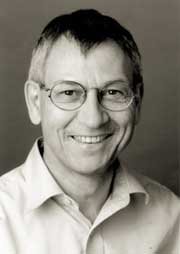|
ERCIM News No.50, July 2002
|
 |
| Rolf Jeltsch, President European Mathematical Society |
Constructing proofs often requires rigorous bounds; to utilise computers one had to replace the standard rounding of floating point arithmetic by a different arithmetic and rounding [‘interval arithmetic’] that preserves bounds in a mathematically rigorous way. For example, Kepler conjectured in 1611 that the tightest method of packing spheres was the ‘natural’ pile for storing cannon balls; in 1998 T.C. Hales proved this and his proof relies on using an interval arithmetic package. Another example is the computer assisted proof by O. Lanford III in 1982 of the Feigenbaum Conjecture, a universal route for functions approaching chaos via period doubling.
Nowadays there are powerful computer algebra systems, like Magma, GAP, Macaulay2, Axiom, to name a few, which are specially designed for handling large and complicated objects in such abstract fields as group theory, geometry, and algebraic geometry.
We can also use computers to find and investigate mathematical conjectures. A visualization of the Costa minimal surface on the computer lead D.A. Hoffman to the proof that it had no self intersections, and this sparked a whole zoo of minimal surfaces. A longstanding challenge for mathematicians is the Riemann Hypothesis, that all ‘interesting’ zeros of the Riemann Zeta function lie on a straight line — this has been confirmed for the first 1,500,000,000 zeros using computers.
All the above mentioned approaches have been used in applications of mathematics. Formula manipulation software (eg, Maple and Matlab) can compute eigenvalues and eigenvectors of complicated matrices with symbolic entries.
Even recently students were trained to differentiate functions and learn which functions could be integrated or which differential equations solved explicitly. Today software does these things more reliably than humans.
In simulation, computing power has made a dramatic impact; nowadays we can handle much more complicated cases and more application areas than one could fifty years ago. Many of the new areas give rise to new theories in mathematics and new algorithms — most prominently genomics, finance and nanoscale technology. The European Mathematical Society (EMS) will organize a conference on application areas jointly with the French Société de Mathématiques Appliquées & Industrielles (SMAI) and the French Mathematical Society (SMF) in Nice, 10-13 February 2003.
Computers have also changed the way we store, retrieve and exchange our information. Years ago we lifted heavy volumes of the mathematical review journals while nowadays we access reviews instantly through the Internet. EMS participates in a EU research project to improve the databank ‘Zentralblatt MATH’. In a world-wide effort, the mathematical community plans to digitise most mathematical literature so that it will be easily accessible and searchable electronically; EMS has sent an expression of interest for the 6th Framework Programme to cover the European part of this huge project.
The computer age and excellent modern communications systems have had an effect on teaching too. Slide rules were replaced by pocket calculators long ago, and soon every student will have a ‘notebook’ and Internet access. Software can be down-loaded; and the Internet provides a wealth of geometric models (which used to be done in clay or by cardboard or wires) and of video sequences demonstrating mathematical theorems (eg, how to turn a sphere inside out in three dimensional space). Software also helps high school students study interactively Euclidean geometry.
New curricula are being developed, the newest one being in Computational Science and Engineering. Use of the computer has boosted the applications of Mathematics in the last fifty years in a dramatic way. I feel it is unfortunate that this has also given rise to the fragmentation of the ‘greater mathematical community’ with many new organisations that do not always have strong contact with each other. Mathematics would be much stronger politically and intellectually if mathematicians would stand together, independent whether they ‘care for applications’ or prefer to ‘stick to fundamental mathematics’.
Rolf Jeltsch
